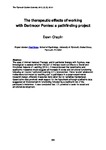The therapeutic effects of working with Dartmoor Ponies: a pathfinding project
| dc.contributor.author | Chaplin, D. | |
| dc.date.accessioned | 2019-05-13T15:45:02Z | |
| dc.date.available | 2019-05-13T15:45:02Z | |
| dc.date.issued | 2010 | |
| dc.identifier.citation |
Chaplin, D. (2010) 'The therapeutic effects of working with Dartmoor Ponies: a pathfinding project', The Plymouth Student Scientist, p. 60-91. | en_US |
| dc.identifier.issn | 1754-2383 | |
| dc.identifier.uri | http://hdl.handle.net/10026.1/13913 | |
| dc.description.abstract |
The area of Animal Assisted Therapy, and in particular therapy with Equines, was investigated to assess whether this sort of therapy could contribute to Social and Emotional Aspects of Learning (SEAL). It was proposed that quantitative and qualitative measures would suggest an increase in social and emotional functioning following an Equine Facilitated Learning (EFL) intervention. Three ‘at-risk’ adolescent males were nominated by teaching staff to participate in a quasi-experimental research design, whereby measures were taken but no variables manipulated. Quantitative data provided weak support for the hypothesis although qualitative data suggested an improvement in functioning followed by a decline in two of the participant’s behaviour. It was concluded that EFL provided a basis for social and emotional development. | en_US |
| dc.language.iso | en | en_US |
| dc.publisher | University of Plymouth | |
| dc.rights | Attribution 3.0 United States | * |
| dc.rights.uri | http://creativecommons.org/licenses/by/3.0/us/ | * |
| dc.subject | Animal Assisted Therapy | en_US |
| dc.subject | Equines | en_US |
| dc.subject | Social and Emotional Aspects of Learning | en_US |
| dc.subject | Equine Facilitated Learning | en_US |
| dc.subject | animals | en_US |
| dc.subject | emotional development | en_US |
| dc.title | The therapeutic effects of working with Dartmoor Ponies: a pathfinding project | en_US |
| dc.type | Article | |
| plymouth.issue | 2 | |
| plymouth.volume | 3 | |
| plymouth.journal | The Plymouth Student Scientist |



